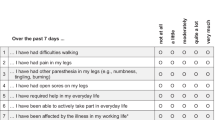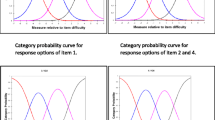Abstract
When considering the use of quality of life as a primary end-point in phase III to IV comparative trials, the trial designer generally faces some unresolved questions. These include:
-
How does one explain that some dimensions [quality-of-life (QOL) instruments usually have more than 1 dimension] are directly influenced by the studied treatments whereas others are not?
-
How can one interpret conflicting results between conventional clinical measurements and QOL measurements, when the relationships between conventional clinical measurement and quality of life are not known?
In this paper, we consider the use of Structural Equation Modelling (SEM) as a methodological alternative to answer these problems. As an example, we analyse the internal causal structure of the Claudication Scale (CLAU-S), a specific QOL 5-dimensional instrument for peripheral occlusive arterial disease. In applying SEM to different studies and different types of calculation, we suggest that CLAU-S is based on a stable, simple and comprehensive QOL model, is compatible with the general International Classification of Impairments, Disabilities and Handicaps (ICIDH) classification, is coherent and complementary with clinical data measurements and, using differences in a prospective study, considerably improves specificity.
We suggest that SEM can help in QOL scale validation, in providing a unified scheme of the inter-relationships between internal dimensions and with external variables, in particular, clinical measurements.




Similar content being viewed by others
References
European Agency for the Evaluation of Medicinal Products. Human Medicines Evaluation Unit. Note for guidance on the chronic peripheral arterial occlusive disease. CPMP Efficacy Working Party — November 1995
Guyatt GH, Veldhuizen Van Zanten SJO, Feeny DH, et al. Measuring quality of life in clinical trials: a taxonomy and review. Can Med Assoc J 1989; 140: 1441–8
Hollenberg NK, Testa M, Williams GH. Quality of life as a therapeutic end-point: an analysis of therapeutic trials in hypertension. Drug Saf 1991; 6(2): 83–93
Chow SC, Ki FY. On statistical characteristics of quality of life assessment. J Biopharm Stat 1994; 4(1): 1–17
Creutzig A, Bullinger M, Cachovan M, et al. Improvement in the quality of life after i.v. PGE1 therapy for intermittent claudication. Vasa 1997; 26: 122–7
Regensteiner JG, Steiner JF, Panzer RJ, et al. Evaluation of walking impairment by questionnaire in patients with peripheral arterial disease. J Vasc Med Biol 1990; 2: 142–52
Finger T, Kirchberger I, Dietze S, et al. Assessing the quality of life of patients with intermittent claudication; psychometric properties of the claudication scale (CLAU-S). Qual Life Res 1995; 4: 122–7
Otis RB, Brown AS, Womack CJ, et al. Relationship between physical activity recall and free-living daily physical activity in older claudicants. Angiology 2000; 51(3): 181–8
Bullinger M, Cachovan M, Creutzig A, et al. Entwicklung eines krankheirsspezifischen instruments zur erfassung der lebensqualität von patienten mit arterieller verschlusskrankheit (PAVK — 86 Fragebogen). Vasa 1996; 25(1): 32–47
Chetter IC, Spark JI, Dolan P, et al. Quality of life analysis in patients with lower limb ischemia: suggestions for European standardisation. Eur J Vasc Endovasc Surg 1997; 13: 597–604
Hunt SM, McEwen J, McKenna SP, et al. Subjective health of patients with peripheral vascular disease: a randomised clinical trial. Practitioner 1982; 226: 133–6
Brevetti G, Perna S, Sabba C, et al. Effect of Propioryl-L-Carnitine on quality of life in intermittent claudication. Am J Cardiol 1997; 79: 777–80
Cook TA, O’Regan M, Galland RB. Quality of life following percutaneous transluminal angioplasty for claudication. Eur J Vasc Endovasc Surg 1996; 11: 191–4
Dietze S, Kirchberger I, Spengel F, et al. Die Claudicatio-Skala (CLAU-S) ein krankenheitsspezifischer Fragebogen zur Erfassung der Lebensqualität von Patienten mit Claudicatio intermittens, Entwicklung und Validierung. Gefaßchirurgie 1997; 2: 11–7
Boccalon H, Lehert P, Comte S. Claudication intermittante et qualite de vie. Validation des qualites psychometriques de la version francaise du questionnaire CLAU-S. J Mal Vasc 2000; 25(2): 98–107
Spengel FA, Brown TM, Dietze S, et al. The Claudication Scale (CLAU-S): a new disease specific quality of life instrument in intermittent claudication. Dis Manage Health Outcomes 1997; 2 Suppl. 1: 65–70
Liard F, Benichou AC, Gamand S, et al. The effects of naftidrofuryl on quality of life. Dis Manage Health Outcomes 1997; 2 Suppl. 1: 71–8
Romney DM, Evans DR. Toward a general model of health related quality of life. Qual Life Res 1996; 5: 235–41
Wagle G. Multivariate beta distribution and a test of multivariate normality. J R Stat Soc Ser B 1968; 30: 511–6
Ponte E, Cattinelli S. Quality of life in a group of patients with intermittent claudication. Angiology 1996; 47(3): 247–51
Hiatt WR, Nawaz D, Regensteiner J, et al. The evaluation of exercise performance in patients with peripheral vascular disease. J Cardiopulm Rehabil 1988; 12: 525–32
Bollen KA. Structural equations with latent variables. New York (NY): J. Wiley, 1989
Loehlin JC. Latent variable model. 2nd ed. Hillsdale (NJ): Lawrence Erlbaum Associates, 1992
Bentler PM, Stein JA. Structural equation models in medical research. Stat Methods Med Res 1992; 1: 159–81
Andrews FM, Withey SB. Social indicators of well being: Americans’ perception of life quality. New York (NY): Plenum Press, 1976
Author information
Authors and Affiliations
Rights and permissions
About this article
Cite this article
Lehert, P. Quality-of-Life Assessment in Comparative Therapeutic Trials and Causal Structure Considerations in Peripheral Occlusive Arterial Disease. Pharmacoeconomics 19, 121–130 (2001). https://doi.org/10.2165/00019053-200119020-00002
Published:
Issue Date:
DOI: https://doi.org/10.2165/00019053-200119020-00002




